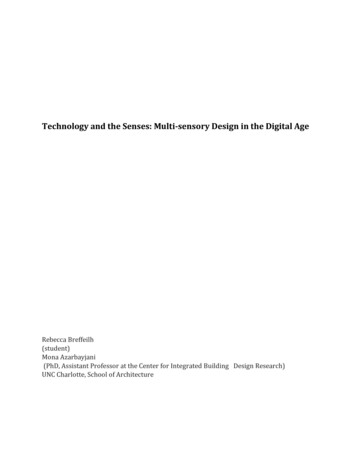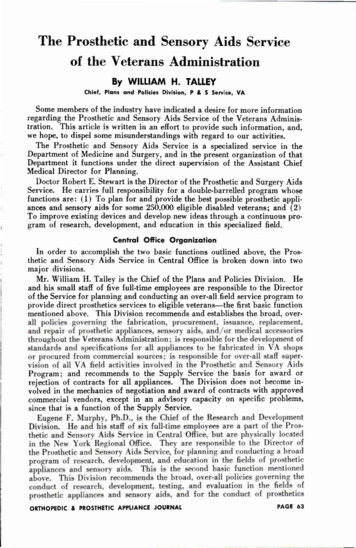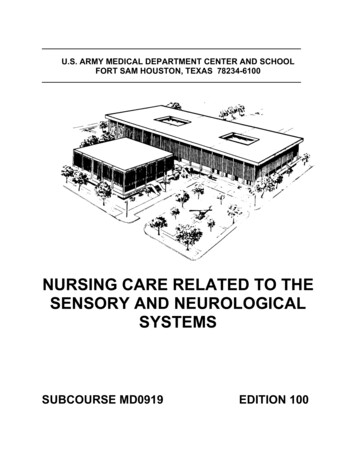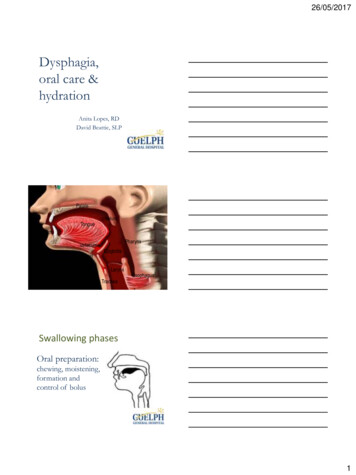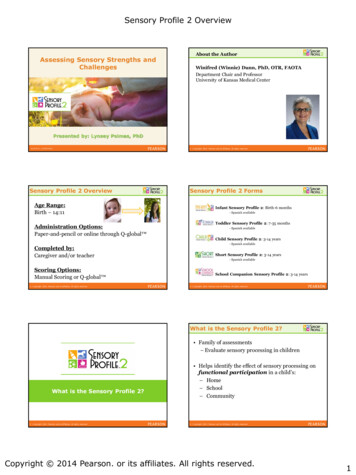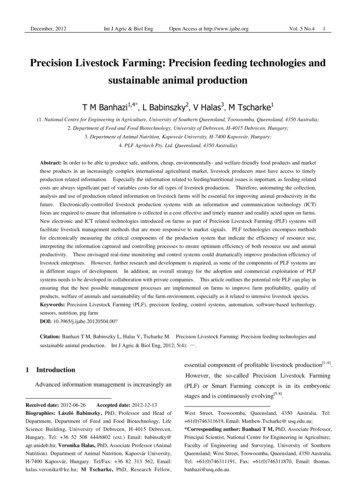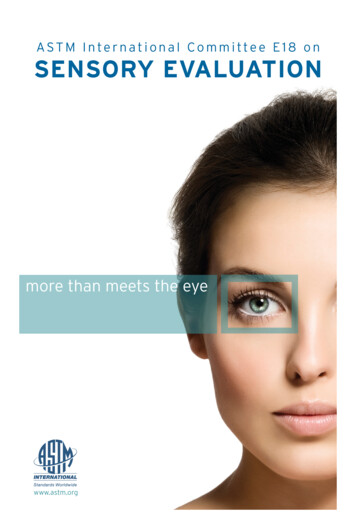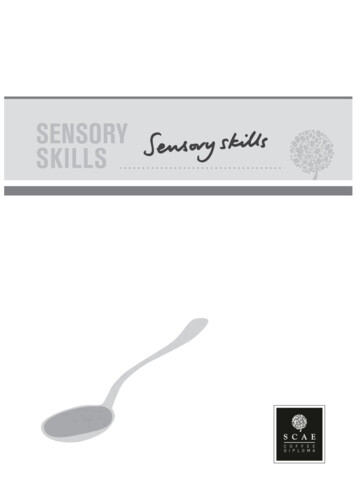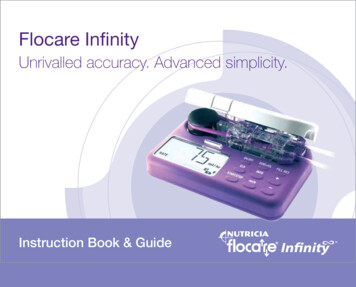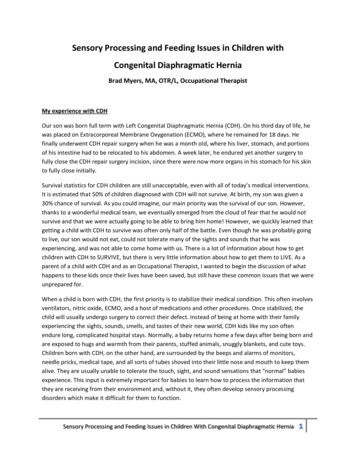
Transcription
Sensory Processing and Feeding Issues in Children withCongenital Diaphragmatic HerniaBrad Myers, MA, OTR/L, Occupational TherapistMy experience with CDHOur son was born full term with Left Congenital Diaphragmatic Hernia (CDH). On his third day of life, hewas placed on Extracorporeal Membrane Oxygenation (ECMO), where he remained for 18 days. Hefinally underwent CDH repair surgery when he was a month old, where his liver, stomach, and portionsof his intestine had to be relocated to his abdomen. A week later, he endured yet another surgery tofully close the CDH repair surgery incision, since there were now more organs in his stomach for his skinto fully close initially.Survival statistics for CDH children are still unacceptable, even with all of today’s medical interventions.It is estimated that 50% of children diagnosed with CDH will not survive. At birth, my son was given a30% chance of survival. As you could imagine, our main priority was the survival of our son. However,thanks to a wonderful medical team, we eventually emerged from the cloud of fear that he would notsurvive and that we were actually going to be able to bring him home! However, we quickly learned thatgetting a child with CDH to survive was often only half of the battle. Even though he was probably goingto live, our son would not eat, could not tolerate many of the sights and sounds that he wasexperiencing, and was not able to come home with us. There is a lot of information about how to getchildren with CDH to SURVIVE, but there is very little information about how to get them to LIVE. As aparent of a child with CDH and as an Occupational Therapist, I wanted to begin the discussion of whathappens to these kids once their lives have been saved, but still have these common issues that we wereunprepared for.When a child is born with CDH, the first priority is to stabilize their medical condition. This often involvesventilators, nitric oxide, ECMO, and a host of medications and other procedures. Once stabilized, thechild will usually undergo surgery to correct their defect. Instead of being at home with their familyexperiencing the sights, sounds, smells, and tastes of their new world, CDH kids like my son oftenendure long, complicated hospital stays. Normally, a baby returns home a few days after being born andare exposed to hugs and warmth from their parents, stuffed animals, snuggly blankets, and cute toys.Children born with CDH, on the other hand, are surrounded by the beeps and alarms of monitors,needle pricks, medical tape, and all sorts of tubes shoved into their little nose and mouth to keep themalive. They are usually unable to tolerate the touch, sight, and sound sensations that “normal” babiesexperience. This input is extremely important for babies to learn how to process the information thatthey are receiving from their environment and, without it, they often develop sensory processingdisorders which make it difficult for them to function.Sensory Processing and Feeding Issues in Children With Congenital Diaphragmatic Hernia1
FeedingOnce the child with CDH has been stabilized and successfully undergone repair surgery, one of the mostcommon, on-going issues that they face is improper feeding/swallowing skills or the complete inabilityto feed at all. Babies are born with the reflex to root and suck for their mother’s breast or the bottlenipple and typically possess the instinct to suck and swallow. Since CDH children are typically only ableto lay flat on their backs in the NICU under sedation, they are unable to consciously feed and slowlybegin to lose their reflexive feeing behavior. Further complicating this issue is the various foreign objectsthat babies have to have in their mouths such as a ventilator hose, a stomach pump (Replogle) tube,and/or a feeding tube that provide constant sensory input and eventually reduce or eliminate thefeeding reflexes. This continues until the child can sustain themselves without all of this extraequipment and are often still unable to go home because they cannot – or will not – eat.Children with CDH often require ventilator and Replogle tubes in serted into their mouths, which affects sensory skils needed for feeding. Theyare also often unable to tolerate auditory or visual stimulation and will require noise-cancelling ear muffs and eye masks.Parents at this stage have now lived through the hell of possibly losing their newborn. While paling incomparison to the debilitating fear of losing your child, feeding issues are one of the most frustratingcomplications that occur with CDH survivors. Not only are the reflexive instincts to root, suck andswallow often lost because of prolonged sensory isolation and constant oral input, the child may find itunpleasant to eat because of reflux or hyper-sensitive gag reflex.Reflux is common in CDH children. The abdominal contents may have already formed incorrectly inutero and may be further jumbled by repair surgery. Because of these issues, the esophageal sphincter,which is typically responsible for keeping stomach contents from coming back up, may be weaker. As aresult, whatever the child eats (as well as stomach acid) comes back up into the esophagus (throat) fromthe stomach. Eventually, the repeated damage to the esophagus from stomach acid makes feedinguncomfortable for the child.Hyper-sensitive gag reflex is often a common issue. Normal children receive constant sensory input totheir mouths through feeding and putting toys and fingers into their mouth. As a result of thesesensations, the gag reflex is normalized to the back of the throat. CDH kids do not receive this sensorySensory Processing and Feeding Issues in Children With Congenital Diaphragmatic Hernia2
input because of the sedation and tubes, so the gag reflex is often much more pronounced. When thishappens, the child may gag whenever anything is inserted, even into the front or middle of the mouth,or may later gag whenever certain food textures are presented. Even if reflux is not an issue with thesekids, a hyper-sensitive gag reflex may cause them to vomit any stomach contents when feeding.The most important thing to remember in either (or both) of these cases is that the child does notunderstand the purpose of feeding. At this age, the child will avoid unpleasant experiences, even anecessary behavior such as feeding. If adults are uncomfortable when feeding, they are able tounderstand that this is a necessary behavior in order to survive and push through it. If babies areuncomfortable, they will not eat. This is often a very difficult concept for caregivers to understand andthey feel like, if they just continue to push the child to eat that, eventually, they will. However, pushingthe child may make the feeding experience even more unpleasant and may be making the feedingdifficulties worse.If your child is experiencing symptoms of reflex (crying, gagging, vomiting, bubbling/gurgling noise aftereating), it is important to speak with your physician immediately. Use of medication can greatly reducethe discomfort associated with eating and turn his process into a more pleasurable experience for thebaby.Some families have also found the use of appetite stimulants successful, however your physician andtherapists should be consulted first. If the child does not have the skills to feed or swallow, increasingtheir appetite could only increase the stress of the infant. They are hungry, but cannot figure out how toeat. If they TRY to eat, but are swallowing incorrectly, this could be a dangerous situation, as food maybe going into their lungs – increasing the likelihood of aspiration pneumonia.Feeding TubesIf the child does not respond to feeding stimuli soon, a feeding tube will be required in order for thechild to receive nutrition. In the beginning, a naso-gastric (NG) tube will be placed, so that milk orformula can be passed through the nose to the stomach. The NG tube is typically a temporary solution,as it is very easily pulled out by the child. Great care must be taken when the NG tube is re-inserted toinsure that it is not inappropriately placed into the child’s lungs. Because of this risk, children typically donot go home with NG tubes and a more permanent tube is placed instead.Sensory Processing and Feeding Issues in Children With Congenital Diaphragmatic Hernia3
Naso-Gastric feeding tubeIf the child’s feeding issues persist and a more long-term solution is required, a Gastric tube (G-tube) willbe inserted. There are different types of G-tubes, depending on where in the child’s digestive system thetube is placed, but they all function on the same premise: nutrition is able to reach the child’s digestivesystem through the abdominal wall, rather than having to be voluntarily processed by the mouth andswallowed by the child.The thought of having a child with a feeding tube of any kind is often difficult for parents and caregivers.When my son was going through this process, we pushed him very hard to accept a bottle, but itseemed like the harder we pushed, the harder he rebelled, and the worse his feeding aversion became.In fact, this is exactly what was happening. Parents often do not understand why their child “just won’teat”. They force their child to accept a bottle or food into their mouth, hoping that they will just learn ontheir own, but what they are doing is making the feeding aversion worse. Again, I believe that this is themost important message that needs to get to parents, caregivers, and medical professionals caring forchildren who have now survived CDH. STOP FORCING THEM TO EAT! It is often in the child’s bestinterest to depend on a feeding tube for nutrition while feeding training or therapy attempts tonormalize the child’s sensory and feeding skills and makes feeding a pleasant experience. Parents andcaregivers need to keep in mind that the feeding tube is not always a permanent solution, as childrenoften wean off of them when they learn to eat enough to sustain themselves. This may be a longprocess, but it is still preferable to creating a child with a permanent inability to eat because of forcefeeding.Feeding TherapyOnce the child’s medical status is stabilized, it is extremely important that sensory therapy is begun assoon as possible. CDH children often require Occupational, Speech, and Physical Therapy to overcomeSensory Processing and Feeding Issues in Children With Congenital Diaphragmatic Hernia4
the issues they developed while medical professionals were saving their life. In some cases, it may beappropriate for the child to receive therapy in the NICU, even when they are sedated or hooked up tomedical equipment, if they can tolerate it. If not, therapy may begin while the child is still in the hospitalin preparation to return home. When the child returns home, they will receive therapy in the home or inan outpatient clinic. Regardless of setting, it is vital that children with sensory and feeding issues begintherapy as soon as they are able to tolerate it. Parents should not take matters into their own hands andtry to resolve feeding issues without professional guidance. If therapy is not directly referred by thechild’s medical team, is completely appropriate for the caregivers to ask for a referral. As with any othermedical profession, different therapists have different specializations. Before beginning therapy, makesure that your therapist is trained in feeding and/or sensory processing habilitation.Feeding therapy can be a slow, but necessary, processMy Son TodayMy wife and I were finally able to hold our son for the first time when he was 6 weeks old. He still reliedon a ventilator to breathe, had a Replogle tube and feeding tube in his mouth and a variety of IV tubes inhis arms and legs. He had endured 18 days on the ECMO machine, 4 surgeries (including his herniarepair surgery) and countless other x-rays, ultrasounds, echo-cardiograms, and other procedures. Abouta month later, he had weaned off of everything but the NG feeding tube. My wife and I knew that ourreturn home was right around the corner – but we remained in the NICU for almost 2 more monthsworking on feeding issues.After 4 months in the NICU at Duke, we finally took our son home with the NG tube. He had a severecase of reflux and it seemed to us that he vomited everything that went into his little stomach. This mustnot have been the case, however, as he continued to gain weight, but still had almost no interest ineating or putting anything into his mouth.We immediately began outpatient Occupational and Physical Therapy, focusing on feeding and sensoryskills. It was a long process, but our son slowly learned to enjoy exploring his mouth during play – andeventually began putting food into his mouth - and eventually began taking small bites- and eventuallybegan to eat! During the week of his first birthday party, we were able to remove the NG tube for good.I cannot tell you how long and frustrating of a process this was, but in the end, it was totally worth it.Sensory Processing and Feeding Issues in Children With Congenital Diaphragmatic Hernia5
Take THAT feeding aversion!!!As of this writing, our son is a fairly normal 4 ½ year old. Despite mild asthma, he plays t-ball andbasketball, is on the neighborhood swim team, and is able to keep up with all of the other kids in his preschool. We still have the occasional issues with certain food textures and vomiting, but overall, hisfeeding habits are essentially similar to other kids his age and he rides the 25% curve on the growthchart for weight. As with any other parent who is at this point in the CDH journey, we have beeninfinitely blessed with knowledge and skills of a miraculous team of doctors, nurses, occupationaltherapists, physical therapists, speech therapists, respiratory therapists . You get the point. Childrenborn with Congenital Diaphragmatic Hernia and their families are faced with seemingly impossible odds.It is my hope that this information will make one aspect of that journey less stressful.I do not intend for this information to be an all-inclusive resource for children with feeding disorders asa result of CDH and I certainly do not want it to be used in lieu of seeking out the advice of experiencedtherapy professionals. However, as this is a process that we have survived and conquered, I am morethan willing to be a resource for others. I can be reached at ecuotr@yahoo.com or on Twitter:@bradmyersotrl.Sensory Processing and Feeding Issues in Children With Congenital Diaphragmatic Hernia6
CDH children often require Occupational, Speech, and Physical Therapy to overcome Sensory Processing and Feeding Issues in Children With Congenital Diaphragmatic Hernia 5 the issues they developed while medical professionals were saving their life.File Size: 442KB
